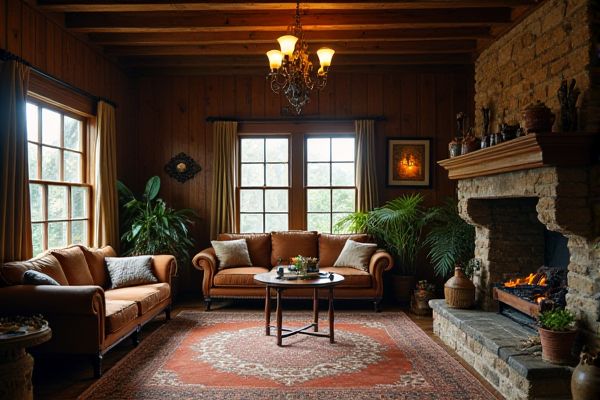
Bug hotels provide shelter for beneficial insects like ladybugs and solitary bees, enhancing garden biodiversity and pollination, while bat houses offer a safe roosting space for bats, which help control mosquito and pest populations. Discover how choosing the right habitat for your garden can support local wildlife and improve your outdoor environment by reading the full article.
Table of Comparison
| Feature | Bug Hotel | Bat House |
|---|---|---|
| Purpose | Provides shelter for beneficial insects like bees, ladybugs, and beetles. | Provides roosting space for bats to rest and raise their young. |
| Primary Occupants | Solitary bees, ladybugs, lacewings, beetles. | Various bat species depending on region. |
| Material | Wood, hollow stems, straw, pine cones. | Wood, plywood with narrow slits or chambers. |
| Location | Mounted on branches, fences, or garden walls in sunny spots. | Placed high on buildings, poles, or trees, ideally 10-20 feet off the ground. |
| Size | Small to medium, varies by insect type. | Medium to large, approximately 24"x14"x3". |
| Benefits | Pollination support, pest control, biodiversity enhancement. | Natural pest control, supports bat populations, biodiversity. |
| Maintenance | Minimal; check annually for wear and debris. | Occasional cleaning after bats vacate; monitor for predators. |
Introduction: Understanding Bug Hotels and Bat Houses
Bug hotels provide essential habitats for beneficial insects like solitary bees, ladybugs, and lacewings, promoting biodiversity and natural pest control in gardens. Bat houses offer safe roosting sites for insectivorous bats, aiding in reducing mosquito populations and supporting local ecosystems. Both structures contribute to environmental health by enhancing pollination and pest management through species-specific habitat support.
Key Differences Between Bug Hotels and Bat Houses
Bug hotels provide shelter for various insects like solitary bees, ladybugs, and lacewings, promoting biodiversity and natural pest control in your garden. Bat houses are specifically designed to attract bats for roosting, aiding in mosquito and moth population reduction. The primary difference lies in their target species and structural design: bug hotels feature diverse compartments for insects, while bat houses offer enclosed, vertical spaces suited for bat colonies.
Benefits of Installing a Bug Hotel
Installing a bug hotel attracts pollinators and beneficial insects that improve garden health by enhancing pollination and natural pest control. Your garden's biodiversity increases, creating a balanced ecosystem that supports native species and reduces the need for chemical pesticides. Unlike bat houses that target specific mammals, bug hotels offer shelter to a wide variety of insects essential for soil improvement and plant growth.
Advantages of Providing a Bat House
Providing a bat house supports local ecosystems by offering safe roosting sites that help control insect populations naturally, reducing the need for chemical pesticides. Bat houses promote biodiversity and aid in the conservation of declining bat species by mitigating habitat loss. Installing bat houses near gardens or agricultural areas enhances pollination and pest management, contributing to healthier crops and balanced wildlife habitats.
Ideal Locations for Bug Hotels vs Bat Houses
Bug hotels thrive in sunny, sheltered spots with diverse vegetation, such as garden edges and flower beds, where they attract beneficial insects like solitary bees and ladybugs. Bat houses require elevated, shaded locations near water sources and open areas for easy flight access, optimizing roosting conditions for species such as little brown bats. Choosing the correct site tailored to each habitat's needs ensures your bug hotel or bat house supports local wildlife effectively.
Design Features: Comparing Structures and Materials
Bug hotels typically consist of stacked natural materials like wood, bamboo, straw, and pine cones arranged in compartments to provide shelter for various insects, promoting biodiversity within gardens. Bat houses are usually made from smooth, untreated wood with narrow, vertical chambers designed to accommodate bat roosting behaviors, featuring ventilation and roughened surfaces to help bats grip. Understanding these distinct design features helps you choose the right structure for supporting either beneficial insects or local bat populations effectively.
Target Species: Insects for Bug Hotels, Bats for Bat Houses
Bug hotels specifically target beneficial insects such as solitary bees, ladybugs, and lacewings, providing them with shelter and breeding spaces to support pollination and pest control. Bat houses are designed exclusively for bats, offering roosting sites that help support their populations and natural insect predation. Your choice between a bug hotel and a bat house depends on whether you want to attract and support insect species or bat colonies in your garden.
Environmental Impact and Ecosystem Services
Bug hotels provide diverse habitats that support a wide range of beneficial insects, enhancing pollination, pest control, and soil aeration, which contribute significantly to ecosystem health. Bat houses offer roosting sites for bats, crucial for controlling insect populations such as mosquitoes and agricultural pests, thereby reducing the need for chemical pesticides. Both structures play pivotal roles in biodiversity conservation and maintaining balanced ecosystems, but bat houses directly impact pest regulation on a larger scale.
Maintenance Requirements and Longevity
Bug hotels require minimal maintenance, usually involving occasional cleaning and replacing natural materials like twigs or leaves to prevent mold and decay, with a typical lifespan of 2 to 5 years depending on exposure to weather. Bat houses demand more regular inspection to ensure structural integrity, removal of parasites, and monitoring for proper bat occupancy, often made from durable materials like cedar, allowing them to last 10 to 20 years or more with proper upkeep. Both structures benefit from seasonal maintenance to maximize longevity and effectiveness in supporting local wildlife populations.
Choosing the Right Option for Your Garden or Yard
Bug hotels provide shelter for beneficial insects like solitary bees, ladybugs, and lacewings that aid in pollination and pest control. Bat houses specifically attract insect-eating bats, which help reduce mosquito populations and improve nighttime pest control. Selecting the right option depends on your garden's ecological needs, space availability, and preferred wildlife attraction.
 homyna.com
homyna.com